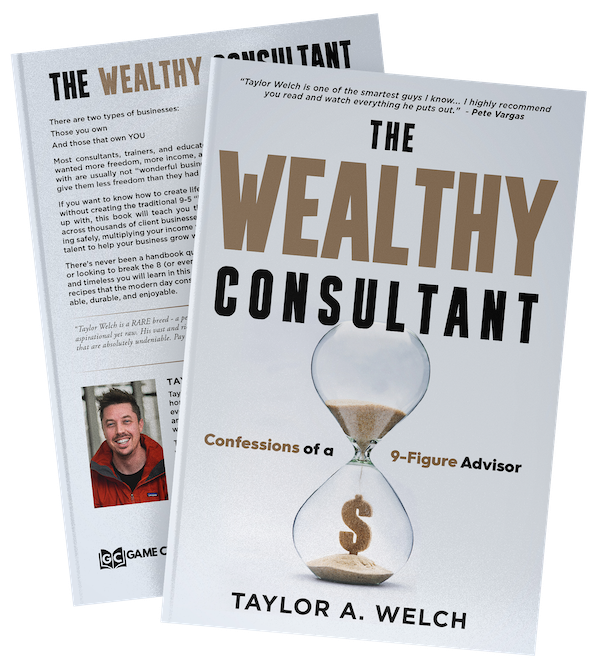Bigger isn’t better. Better is better.
So many gurus have made their fortunes on the back of the idea that acquisition is the biggest “problem to be solved” in any business. That how you market the offer somehow trumps the content of the offer itself.
Let’s get real for a minute.
- Good marketing can’t outrun a bad offer.
- Stellar salesmanship can’t outpace it.
- The most structured, systematized fulfillment can’t stop the refunds.
In other words, how you structure your offer not only matters, it can be the difference between success or failure for your entire business.
Because, if you nail the offer itself, the:
- Marketing becomes easier
- Sales become easier
- Fulfillment becomes easier
Let’s look at the 3 components of any premium offer.

Market – A Clearly Defined “Who”
The very first component of any offer is the Market.
Put simply, this is your “who” – the person that the offer is designed to serve.
This has to be the foundation of any successful offer because it steers the entire direction of both your sales and marketing efforts. It’s difficult to craft compelling messaging that addresses or agitates the pains/problems of your market if you don’t actually know who the hell they are.
Having trouble getting clarity on your “who”? Check out this 3 step filtering framework:
- MACRO – What are their primary motivators? Hint: There are only 3 – Health, Relationships, and Money (all the others fit somewhere within these 3).
- MICRO – What are their demographics and pyschographics? Hint: If you are a more traditional brick-and-mortar business, you’ll need to consider demographics. If you’re an online business, it’s all psychographics.
- CUSTOM – What is the exact problem/solution you want your offer to address for this person? Hint: This is where you want to get as detailed as humanly possible, as this is the “fine tuning” measure that narrows your market and allows your marketing to be lethal.
Solution – A Clearly Defined “What”
You have your market. You know exactly who the ideal person is for your offer (practically right down to their sex, age, and shoe size).
Now it’s time to outline exactly what it is that you want to help them achieve. This is called your “solution.”
Fortunately, you already began this work when you were defining your market earlier (in the “Custom” step of the filtering framework). Again, this is where you want to employ as much detail as possible, as this will help inform your marketing and sales processes.
- Is this fixing a pain for them?
- How painful is this issue for them? (Rate it – define it as much as possible)
- What would it feel like for them to have that pain removed?
- Is this creating or increasing pleasure for them?
- How much do they desire that pleasure? (Rate it – define it as much as possible)
- What would it feel like for them to achieve it?
- How long would it take them to fix that pain or achieve that pleasure without your solution?
- Does your solution do BOTH – fix a pain and increase pleasure? (This is the money zone for potent offers)
Spend time thinking, analyzing and answering as many questions as you possibly can about what you want to help your ideal market actually achieve.
Important note – you can’t solve a problem for your market that they DO – NOT – HAVE. Do your homework. If your solution isn’t aimed at fixing an issue that your ideal client actually struggles with, or providing a pleasure that you absolutely know they want, you’ll waste a whole lot of time trying to craft marketing that “convinces” them… only to ultimately fail. You can’t create desire for your solution. You can only uncover, agitate, or manipulate existing desire. This is why we always start with defining the market, and getting a crystal clear understanding of who they are and what they want/need.

Method – A Clearly Defined “How”
Obviously, it’s not enough to know who you want to help and what you want to help them do.
What separates the real experts from the “wanna-preneurs” is their ability to deliver. And delivering on your solution requires a method.
This is the means by which you will help your market achieve the solution you’re promising them.
There are essentially two types of methods:
- Labor – you do the work for them
- Information – you teach them to do it
Outlining this process in painstaking detail is a key to not only helping you (and your team) get clarity on how it works, but also eases the burden on your sales team to fill in gaps for prospects later. (Hack: Diagram the entire process to achieving your solution, step-by-step, in something like Lucid or Miro – then export it and give it to your sales team as a deliverable to give to hot prospects during the sales process.)
Clarity is the Key
In case you’re not seeing the trend here, the whole process of creating a monster offer is centered on getting one thing – clarity.
- Clear market
- Clear solution
- Clear method
The more defined and detailed your ICPs (ideal client profiles – more on those here) are, the more targeted your messaging will be. A recipe for superb marketing.
The balancing act is in making your market, solution and method NARROW enough to give specificity and laser-focus to your messaging, while not making it so narrow that it shrinks your TAM (total addressable market) and caps your business. This requires thought and intentionality on your part. You want to “niche down,” and find a very specific group of people to market your services to – but you also want to make sure that group of people is large enough to help you scale your business.
It’s worth devoting plenty of time to this, talking it out with people you trust, and getting feedback from your audience. After all, the strength of your offer will translate to the strength of your overall business.
One final note on this. Once you peg your 3 pieces and establish your offer, it is not set in stone forever. You can, and should, regularly analyze it and make sure that it best suits the needs of your clients. Markets change, and their needs evolve over time. Your offer must do the same!
If you’ve got questions about how best to structure your offer, or would like a more substantial breakdown of the ideas in this article, click here to schedule some time with a member of our team. They’ll talk through the offer with you, ask some questions, and help you craft a business that can stand the test of time. It’s what we do!

Have More Questions About Offers?
We really can’t point you to a better resource than Taylor Welch’s recent book, The Wealthy Consultant. Inside these pages, Taylor breaks down 15 unique models for building healthy, sustainable consulting businesses – including his thoughts on crafting offers.

